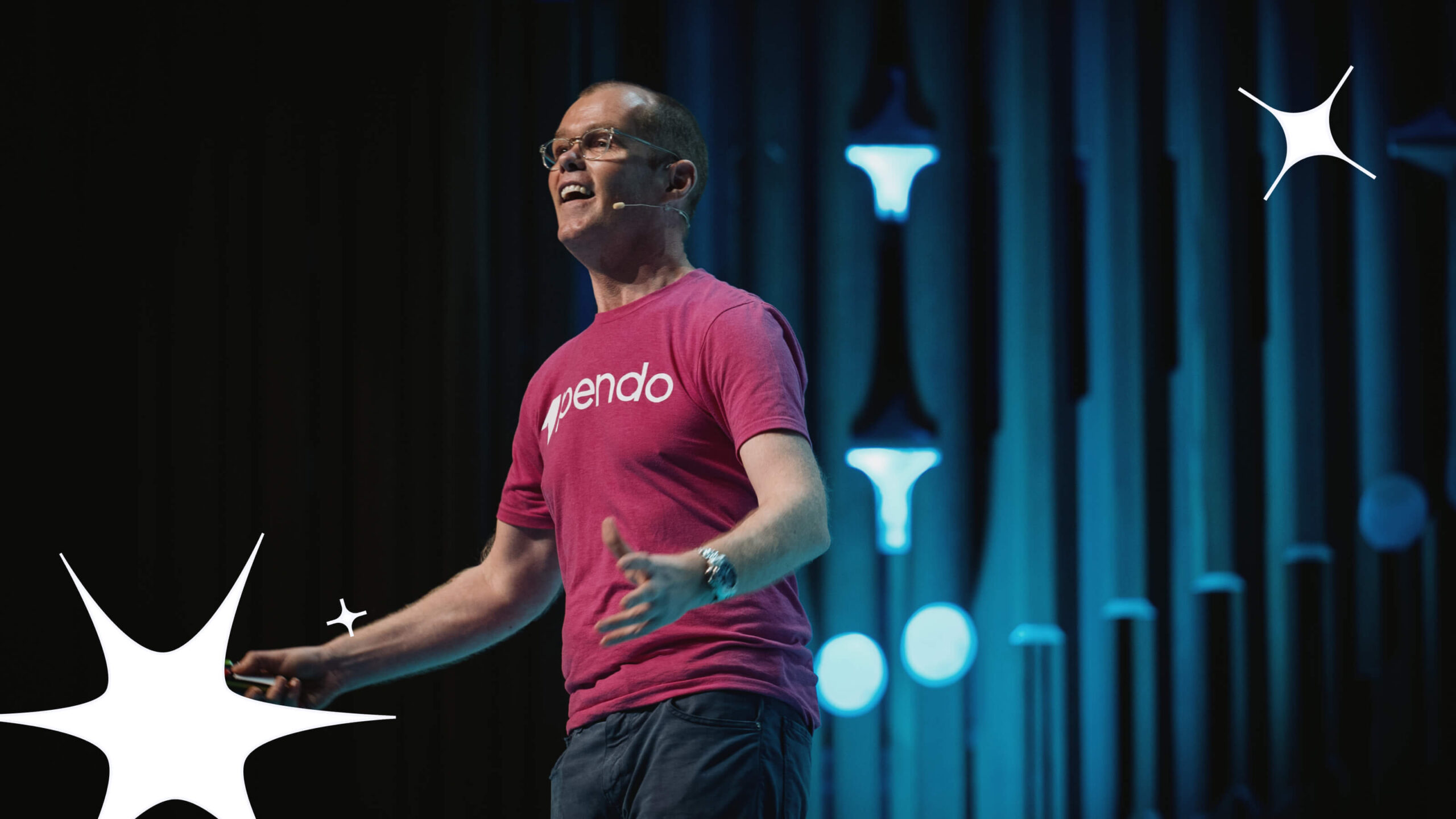過去1年間に新しいソフトウェアの導入を承認してもらおうとした経験がある方なら、非常に限られた予算の中で会社の経営陣、特に財務責任者に、ソフトウェアツールに投資してもらうことがいかに難しいかおわかりかと思います。しかし、もし現在使っているプロダクト体験に関するツールがポイントソリューション(1つの課題のみを解決するソリューション)の寄せ集めである場合、複合的な機能を提供するプラットフォームソリューションよりもコスト、生産性、運用の面において多くの無駄が発生してしまっている可能性があります。
- 異なるデータセットを使用して作業している場合(またはデータにまったくアクセスできない場合)、チームは客観的な行動のインサイトに基づいてでなく、これまでに養われた勘で意思決定をしてしまいます。その結果、コラボレーションが減ったり、プロダクトのイノベーションが停滞したり、必要とされていない機能を開発したりするようになり、最終的には顧客体験に悪影響を及ぼします。
- 複数のポイントソリューションをなんとか寄せ集めて使用しても、うまく連携できずに何かを壊したり誤送信したりすることを恐れて、プロダクトに関するデータやアプリ内ガイド、またはフィードバックツールへのアクセスが民主化されません。これでは、購入したツールを実際に大規模に展開して運用上の課題を解決することは不可能です。
- 多数のベンダーと仕事をしていると、調達チームとエンジニアリングチームのために大量の書類が作成されます。多数のベンダーとの関係やプロダクト仕様を切り盛りしていると、承認、実装、インテグレーション、および保守が困難になります。そして最終的には、すべてのベンダーチームから必要な支援を得るために、仲介役に徹する羽目になります(さらに多くの費用も必要になります)。
「フランケンスタック(ソリューションのつぎはぎ)」から統合型プラットフォームに移行するメリットは具体的にはなんなのか?ポイントソリューションがビジネスの速度を低下させている主な理由と、Pendoのような統合されたプロダクト体験プラットフォームがどのように役立つかを詳しく見てみましょう。
ツールが相互連携していない
ポイントソリューションを組み合わせて独自のプロダクト体験スタックを構築している場合、それらのツールを連携させるためのインテグレーションや接続ポイントの構築に、必要以上の時間とリソースを費やしている可能性があります。そして、おそらく思っているよりもはるかに多くの費用がかかっています。
たとえば、あるツールをプロダクトアナリティクスに使用し、他のツールをアプリ内ガイドのために使用しているとします。真にデータ駆動型のガイドを提供するには、開発チームがカスタムコードを作成して2つのシステムを相互に連携させる必要があります。また、さまざまなツールへのデータの移動や分類に膨大な時間を費やす必要もあります。そのため、動きのない古い情報に基づいて作業し、意思決定を行うことになる可能性が高くなります。これは、データへの信頼性の欠如につながり、コンセンサスを得ることや迅速な反復が難しくなります。
複数のツールを使うと、それぞれに独自の操作画面があったり、その使い方を学習する必要があるため、たとえばプロダクトチームにとっては非常に非効率的です。企業全体がプロダクトの健全性、アプリ内ガイドのパフォーマンス、顧客フィードバックの状態を評価できる一元管理されたツールがなければ、異なるデータ源からさまざまな方法で得た情報を使用することになり、一貫性のないレポートが生成されます。この方法では、差し迫ったプロダクトの質問に対する回答を得るのに時間がかかり、意思決定プロセスの不確実性が増し、協調した行動をとることが非常に難しくなります。
また、複数のベンダーとやり取りすることは、本当に必要な支援を得ることができないことも意味します。ポイントソリューションを提供するベンダーは、ツールが関与するプロダクト体験の一部しか見えないため、全体像を把握していません。そのため、あるプロダクト分野で学んだことをビジネス全体の他のプロダクト分野に適用する機会を逃し、プロダクトの成功をビジネス全体の成功に結び付けるのが非常に困難になります。一方、プラットフォームを活用したアプローチでは、プロダクトライフサイクル全体を見渡しながらプロダクトとビジネスの目標を理解し、ジャーニーのあらゆる段階で、関与するチームを戦略的にサポートすることができます。
顧客体験を危険にさらし、拡張を妨げている
顧客が通常、舞台裏のフランケンスタックに気付くことはおそらくないでしょうが、何か問題が発生したときにその統一感のなさを感じることは確かです。なぜなら、社内チームのために多数のポイントソリューションを管理することは運用上のストレスであり、これらの接続ポイントやシステムインテグレーションの1つが壊れたり失敗したりした場合に、ユーザー体験をリスクにさらすことにもなるからです(そしてその可能性は低くありません)。
たとえば、アプリ内ガイドのソリューションがプロダクトアナリティクスのソリューションと同期しなくなった場合、誤ったメッセージを誤ったユーザーグループに対して配信してしまい、顧客が混乱するだけでなく、最悪の場合は顧客の怒りを買って解約につながる危険性もあります。このような一見小さな問題でも、繰り返されるとブランドに対する顧客の信頼を損なうことになり、タイミングの悪いガイド表示や誤ったターゲットへのメッセージ送信、ワークフローの中断などが重なることで、全体的なユーザー体験の低下につながります。
このような自社で行うインテグレーションは、信頼性が低いだけでなく、すぐに管理が難しくなる可能性があります。また、開発部門には高額なコストがかかるため、すでに多忙なエンジニアがカスタムコードを作成し、うまく連携しないソリューションをつなぎ合わせる必要があります。これらすべてが結局のところ、思っているよりも運用に時間がかかることにつながります。なぜならチームは貴重な時間を費やして即席でツールを組み立て、データに基づき行動を起こすために、なんとか動作するシステムを開発しているに過ぎないからです。
総所有コストは青天井
比較的低コストのポイントソリューションは非常に得だと思われるかもしれません。これにたった数十万円、あれには数百万円といった具合に、いろいろ揃えることで安価でありながらたくさんのものを得ているように感じます。しかし実際には、異なるシステムのつなぎ合わせは、連携して機能するように設計されたツールを使用する単一プラットフォームに投資する場合よりも、長期的にははるかに多くのコストがかかってしまいます。
すべてのプロダクト体験ツールを統合プラットフォームにまとめることで、複数のベンダー(および複数の実装、サポート、サクセス、技術チーム)と連携する必要がなくなり、運用上の問題と、開発部門がカスタムインテグレーションに向けてコミットする必要がある作業量の両方が軽減されます。ライセンス費用をわずかに節約したとしても、非効率的な技術は目標達成を妨げ、運用コストも増加させます。そして、実装、保守、インテグレーション、サポート、システムインテグレーションのコンサルティングにかかる(たいてい隠れた)追加費用を考慮すると、フランケンスタックの総所有コストは天文学的に高くなります。
さらに、多数のベンダー契約を管理すると財務責任者も運営責任者も神経質になります。ベンダーが増えると契約が増え、承認に要する時間が長くなり、セキュリティ違反やサービス停止が発生した場合のリスクも高くなります。断片的なスタックを実行するコストは常に予測を上回り、次第にチームは最も重要なこと、つまり優れたプロダクト体験と顧客体験を提供することに集中できなくなります。
Pendoのようなプラットフォームを利用すれば、調達プロセスを簡素化し、成功のために尽力する熟練したチームと強い関係を築き、連携して業務効率を上げるよう設計された一連のツールを利用して、よりスマートなプロダクト決定、効率的な運営、影響の拡大を可能にすることができます。詳細については、プラットフォームのセルフガイドツアーをご覧いただくか、 担当チームにお問い合わせください。


